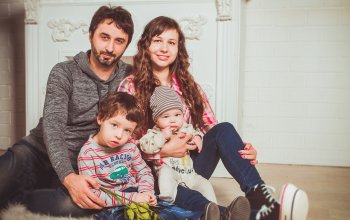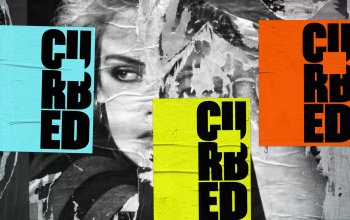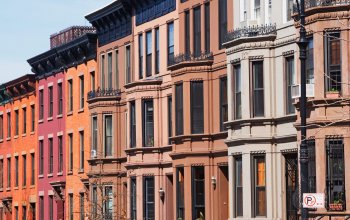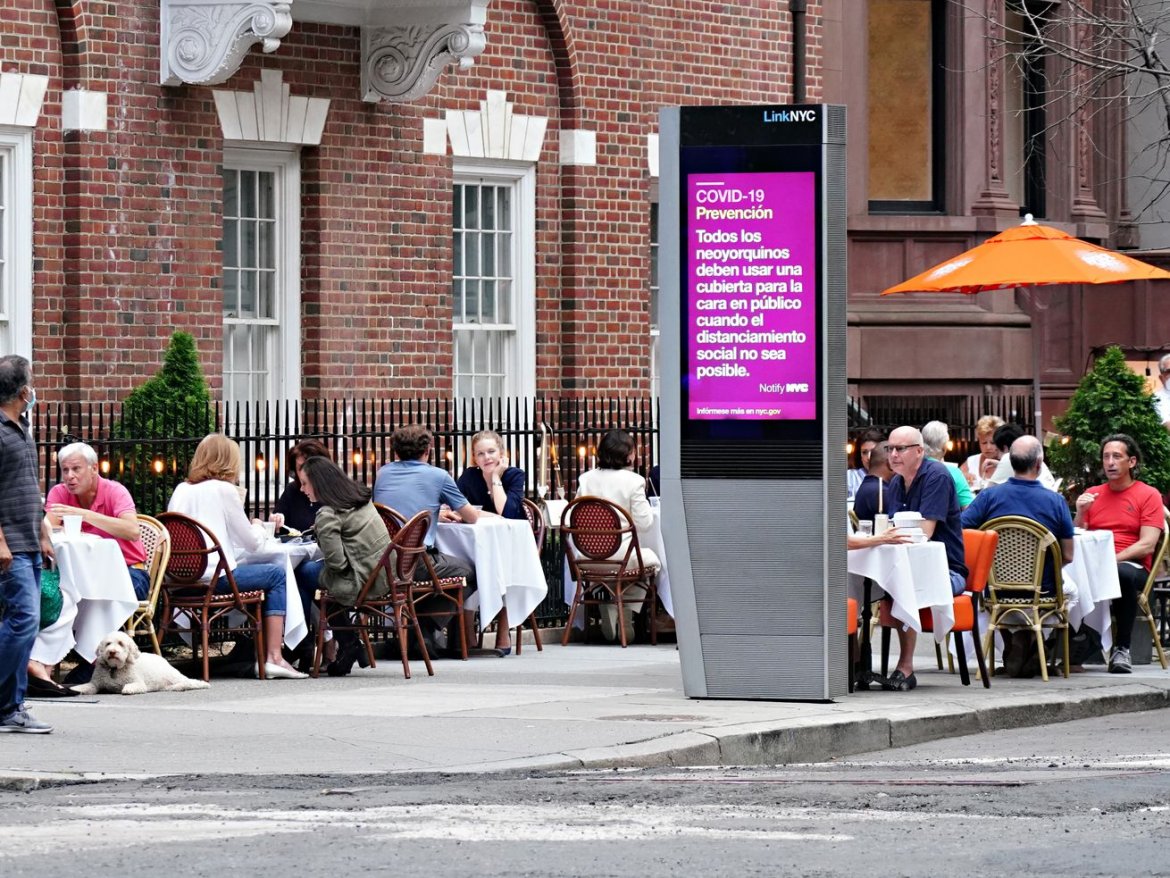
Everything You Need To Know About NYC’s Reopening
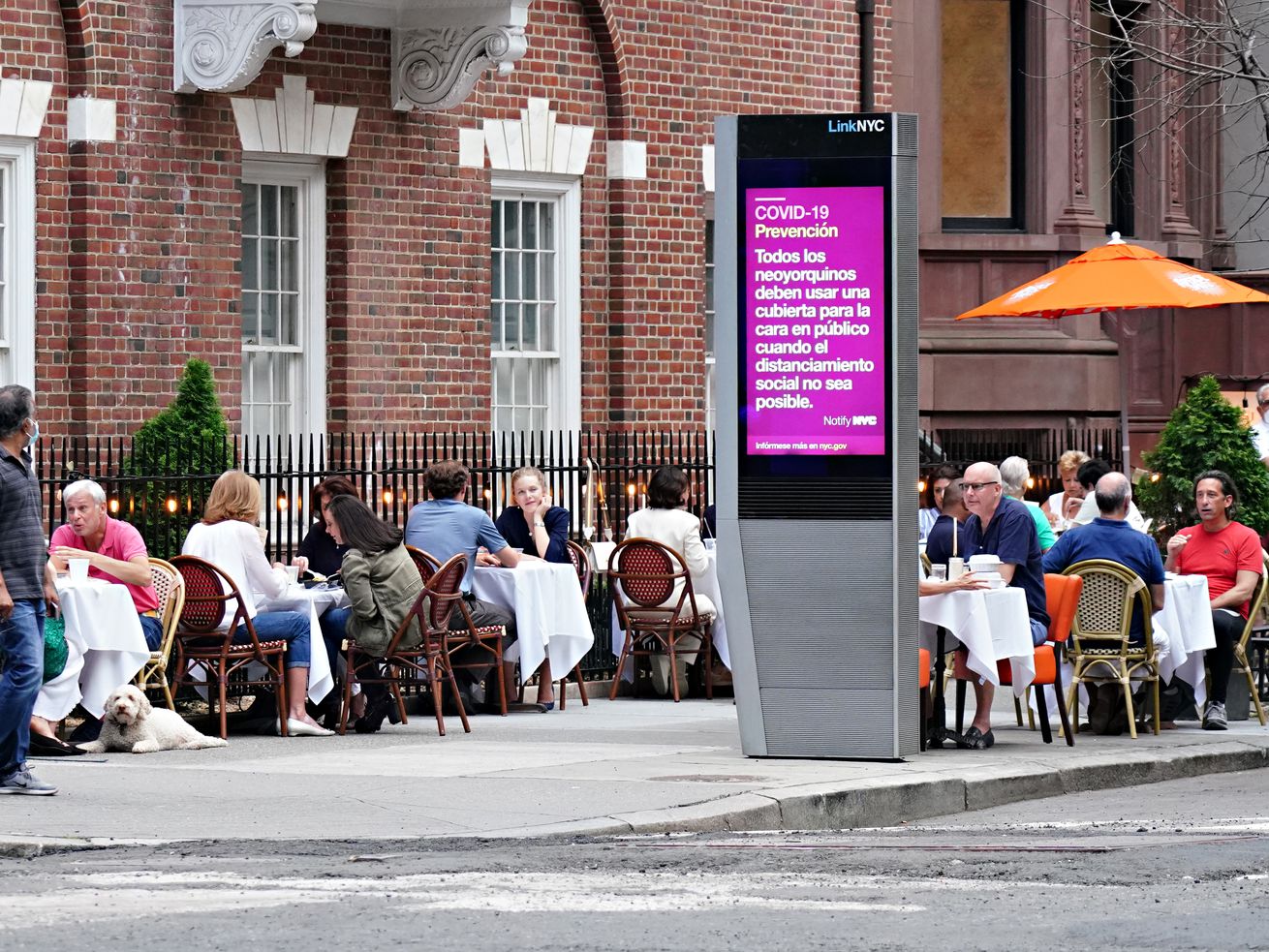
 A restaurant on Madison Avenue serves drinks to customers seated at sidewalk tables as the city moves into phase two reopening. | Cindy Ord/Getty Images
A restaurant on Madison Avenue serves drinks to customers seated at sidewalk tables as the city moves into phase two reopening. | Cindy Ord/Getty Images
Here’s what you need to know in New York City
New York City, once the epicenter of the coronavirus pandemic in the U.S., has entered its second phase of a four part reopening to tentatively restart the city’s economy.
Since late March, New York has been all but paralyzed under the novel coronavirus pandemic with more than 209,000 confirmed cases across the boroughs and over 22,000 lives lost to the virus.
Under Gov. Andrew Cuomo’s executive PAUSE order, nonessential businesses were shuttered and restaurants were open only for takeout and delivery—nearly 900,000 jobs vanished practically overnight. As of June 8, New York City began its gradual road to recovery with its first phase of reopening: As many as 400,000 workers returned to construction jobs, manufacturing sites, and retail stores as the city broadens its definition of essential worker.
Now, two weeks later on June 22, the city is moving into its second phase of reopening with with up 300,000 employees expected to return to their jobs as outdoor dining, in-store shopping, and office work resume.
The city is not out of the woods yet, with 500 new cases each day—roughly half the number of new cases just a few weeks ago—but officials say those numbers are low enough for the city’s newly formed corps of contract tracers to work to hinder another major outbreak. City and state officials say they are optimistic about building on the city’s progress.
“This is clearly the hardest place in America to get to this moment because we were the epicenter,” Mayor Bill de Blasio said recently of the city’s reopening. “We’ve gotten all this way, let’s keeping holding on to it and building on to it.”
Other parts of the state began reopening in mid-May after meeting seven public-health benchmarks set by Governor Andrew Cuomo. In the first phase of reopening, retail stores can open for curbside or in-store pickup and nonessential construction and manufacturing may resume. The governor cautioned that reopening does not mean a return to business as usual.
“Remember, reopening does not mean we’re going back to the way things were,” Cuomo said while discussing reopening plans. “It is reopening to a new normal. It’s a safer normal.”
Here’s how things are going down in New York City, including closures/reopenings (we’ve focused our list on public spaces, such as parks and cultural institutions), mass transit provisions, and updates on assorted gatherings. For more information on the pandemic and the impact on the restaurant industry, check out the New York Times and Eater NY. If you’re wondering how to help people impacted by the outbreak, the Times also has you covered.
New York City launches its second phase of reopening. As of June 22, two weeks after it began easing restrictions, New York City marked another major milestone by entering its second phase of reopening. Much larger than the initial phase, this portion of the city’s reopening allows for thousands of offices to welcome back employees for the first time since March. Under the plan, outdoor dining, some in-store shopping, hair salons, barbershops, real estate firms and offices are permitted to open their doors.
Restaurant owners, who have seen business plunge during the pandemic, have been particularly worried that even as the city reopens, mandates requiring them to limit capacity and put distance between their tables would make it difficult to make ends meet.
Many restaurants and bars, especially in Manhattan, do not have available outdoor space, and owners have for weeks pressed the mayor and lawmakers to expand their ability to serve patrons outdoors. Three days before the second phase, de Blasio finally unveiled the “Open Restaurants” plan to give eateries that sorely needed space.
To move forward with the reopening process the city must continue to meet certain health and testing metrics in order to gradually relaunch its economy.
New York tentatively begins to reopen. On June 8, as many as 400,000 workers began returning to construction jobs, manufacturing sites, and retail stores in the first of a four phase reopening plan. The city took its first step to restarting its economy three months after the novel coronavirus pandemic upended life in the city, claiming the lives of 22,000 residents and infecting more than 209,000 others.
The gradual easing of state restrictions came after Cuomo issued an executive order in late March, which the governor dubbed PAUSE—“Policies Assure Uniform Safety for Everyone.” That order, mandates that any businesses not deemed “essential” must keep 100 percent of their workforce home, is still in effect. Instead, the definition for an essential worker has been broadened to include new industries.
As part of the initial reopening, work resumed at over 30,000 construction sites, where employees are required to wear masks and maintain six feet of distance. Site managers will have to provide hand sanitizer and keep logs of all workers. The city says it is aggressively enforcing new state-outlined workplace safety measures.
New York City remains under a state of emergency. Mayor Bill de Blasio issued the order on in early March, which gives his administration the power to “take all appropriate and necessary steps to preserve public safety.” Under a state of emergency, the mayor could impose a curfew for the city—as he did during the George Floyd protests—and close mass transit.
De Blasio has also encouraged New Yorkers to sign up for smartphone alerts straight from the city—text COVID to 692 692 to get those.
Groups of ten can now gather in New York for any reason. In May, Cuomo slightly loosened coronavirus restrictions, saying that gatherings of up to ten people would be allowed “for any lawful purpose or reason” anywhere in the state, including New York City, provided that social distance protocols are followed.
New Yorkers ordered to cover their face if they can’t socially distance. Cuomo has issued an executive order requiring people to wear face coverings in public where they can not keep six feet away from others. More recently, the governor issued another executive order giving private businesses the power to deny entry to customers who are not wearing masks or other face coverings.
MTA suspends overnight subway service for the foreseeable future. The state and city will coordinate on an effort to halt subway service between 1 and 5 a.m. each night in an effort to disinfect every train every 24 hours. The unprecedented service change, which will shutter all 472 subway stations for four hours every night, began on May 6.
For essential workers who need to take the subway during the early morning hours, the state and city will provide alternate service—buses, dollar vans, and even for-hire vehicles—to get people moving, at “no cost to the essential worker,” according to the governor. Disinfecting subways and buses every day, Cuomo argues, is the “best way to protect our essential workers.”
The MTA restores full subway and bus service during the day. Under the MTA’s Essential Service Plan, the authority slashed service as subway and bus ridership hit historic lows of more than 90 and 80 percent, respectively, compared to this same time last year and as COVID-19 hobbles the authority’s frontline workers. Now, those cuts have been restored as transit workers return to work and as the city moves into its first phase of reopening.
Keep an eye on the MTA’s various Twitter accounts—NYCT Subway and Bus, LIRR, Metro-North, and the agency’s official account—for service updates.
New York City to roll out 20 miles of new bus lanes. De Blasio has announced plans to create 20 miles of car-free busways and dedicated bus lanes across all five boroughs starting this month, along with making the successful 14th Street busway permanent. But that milage is short of the 60 miles of bus lanes the MTA and transportation advocates called for as the city begins is first phase of reopening.
The city is closing 100 miles of streets to vehicular traffic during the pandemic. Mayor Bill de Blasio committed in April to close up to 100 miles of streets to promote social distancing during the novel coronavirus pandemic. So far the city has closed 35 miles of streets and created just over 9 miles of temporary protected bike lanes.
The New York Stock Exchange has re-opened its trading floor. The stock trading floor of the New York Stock Exchange reopened in late May, though at a reduced capacity to allow space for social distancing measures to remain in force.
Alternate side parking is suspended until June 28. Alternate Side Parking suspensions will continue through June 21 and may be may extend based on street cleanliness and workforce availability.
Airports remain open. Flights are still going in and out of JFK, LaGuardia, and Newark Airports, although the CDC has recommended anyone in the New York City area suspend travel for the next two weeks. If you’re unsure about your flight’s status, check with your individual carrier. Important to note: Travel restrictions and new screening measures have led to massive crowds at many airports.
The Port Authority of New York and New Jersey, which operates those airports (as well as two bus terminals and the PATH train) has upped how often it cleans high-touch areas in those spaces, and has added hand sanitizing stations in the airports.
Ferry schedules have been disrupted. The Staten Island Ferry is running every 20 minutes in rush hour. On the NYC Ferry, weekend service will remain the same, but weekday schedules will be affected.
Citi Bike is offering free memberships for essential workers. Those who work in health care, for the city’s transit systems, or as first responders qualify.
Evictions are suspended until mid-August. New York state has suspended eviction proceedings and pending eviction orders until August 20. Here’s everything you need to know about the moratorium.
The city’s tourism industry has been disrupted. Major tourist attractions—including the Statue of Liberty, Ellis Island, the Empire State Building, Rockefeller Center, and Hudson Yards—have closed to protect potential attendees from COVID-19, but this may lead to a significant dip in the city’s economy, which relies on visitors’ dollars.
Public meetings are going digital. Some city agencies are making a virtual comeback. The City Council held a digital stated meeting on April 22 for the first time in its 82-year history and his continue with digital hearings ever since. That same week, the Landmarks Preservation Commission (LPC) launched virtual public hearings, allowing applicants to present their projects remotely and for New Yorkers to provide live testimony. The Rent Guidlines Board has also hosted virtual hearing ahead of its June vote on the allowable increases for the city 1 million rent stabilized apartments.
The city’s land use review process has been suspended. De Blasio has paused the city’s Uniform Land Use Review Procedure (ULURP), which is a public approvals process for development proposals that unfolds over seven months and culminates in a City Council vote. Developers who wish to build projects that differ from a property’s existing zoning must file a ULURP application.
All city-permitted events are canceled through June. That includes major parades and public events like the Puerto Rican Day Parade and the Pride March, both of which typically take place in June. But de Blasio made the somewhat perplexing promise that the annual Macy’s Fourth of July fireworks would light up the sky despite the pandemic.
Broadway has gone dark. All 32 plays and musicals that are currently on Broadway have been suspended until the fourth and final phase of the city’s reopening.
Other major performing arts centers have followed suit. Lincoln Center has suspended most, if not all, of its performances through the summer, which includes those at the Metropolitan Opera, the New York Philharmonic, New York City Ballet, and Film at Lincoln Center. Carnegie Hall also suspended its entire 2020-2021 season. The Shed has canceled all performances. The 92nd Street Y has also canceled its talks and performances. The Brooklyn Academy of Music is also on hold. Shakespeare in the Park has canceled its entire 2020 season, and other summer stalwarts—including Celebrate Brooklyn!, Governors Ball, and Lincoln Center Out of Doors—are also canceled.
New York City museums have closed. The Metropolitan Museum of Art says that it expects to remain closed until August, for example. But you can still check out the collections of many institutions online. Many museums are sharing work from their collections with the hashtag #MuseumFromHome on Twitter, which is a nice follow in these times.
Sporting events are on hold. The NBA has suspended its 2020 season after a player for the Utah Jazz tested positive for COVID-19; other leagues, including the MLB and NHL have suspended games for now. This means no more Knicks or Nets games for the time being, and the start of the Yankees’ and Mets’ seasons will be delayed, among other changes for NYC-area teams.
Many major arts and design events have been postponed or canceled. That includes NYCxDesign, which typically happens in May and will now take place in October; the 2020 Kips Bay Decorator Show House, which has been postponed until later this year; and Frieze New York, which has been canceled.
New York City will limit crowds at two parks. But the vast majority of the city’s parks remain open and unrestricted. Police are limiting crowds at two piers, Hudson River Park and Domino Park, after viral photos of sunbathing crowds. The crowd limits at the two parks will take different forms: At Hudson River Park, police will limit the number of people at Piers 45 and 46 in Greenwich Village; at Domino Park, on the East River in Williamsburg, the city will increase police presence and monitor crowd sizes. In both cases, however, officials will limit the amount of time people spend in those parks to crack down on overcrowding.
It’s important to note that while most other parks are unaffected, the facilities within those parks are closed, including playgrounds, dog runs, nature centers, and basketball courts. The Brooklyn Botanic Garden, Queens Botanical Garden, New York Botanical Garden, and Wave Hill are now closed. The Snug Harbor Cultural Center on Staten Island is also closed. Community gardens are also now closed except to members who maintain them. The Parks Department is preparing for the possibility that the city’s beaches may partially or entirely close throughout the summer, which would have typically opened Memorial Day weekend.
Gov. Cuomo waived entry fees at New York’s state parks to allow cooped-up residents to get outdoors, but at a safe remove from one another. Remember: If you go to a park, stay at least six feet away from any other people who are out and about, and wash your hands thoroughly before and after you go.
New York is preparing to keep residents cool during the summer. The city is working to identify new cooling centers that could accommodate social distancing and will provide free air-conditioners to low-income seniors.
New York City’s library systems have closed their doors. This includes all branches of the New York Public Library, the Brooklyn Public Library, and the Queens Public Library. Each system has various services available remotely, which they’re encouraging New Yorkers to use during this time.
Most New Yorkers are working from home. Many companies across the city have instituted work from home policies for employees, based on social distancing recommendations from the city and state. If you’re among the newly minted group of those telecommuting, here are some tips on how to be productive and not go stir-crazy in the process—and some tips if you’re inside with kids.
Love where you live
